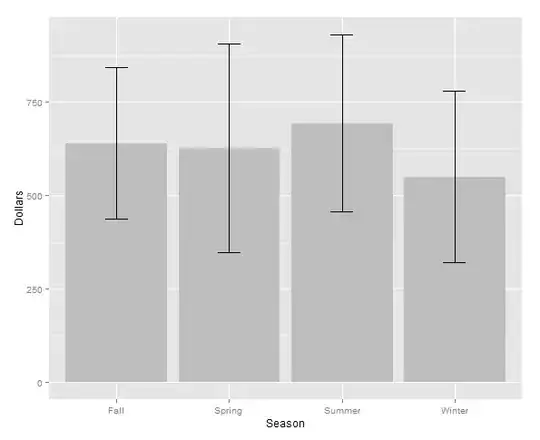@nick-eng pretty much answered it all (+1)! I just thought I could add some examples to illustrate his points and to show why the long-format (your first table) is more efficient to work with, especially when you are working with Hadley Wickham's R packages ggplot2 and plyr. But I do have to say that I often prefer to use the wide-format when reporting mean values in manuscripts.
-- Begin edit --
As @ttnphns rightly points out (see comment under OP's question), many analyses require the data to be in the long-format, whereas multivariate analyses usually need to have the dependent variables as individual columns. This also holds for repeated measures when analyzed with the Anova function of the car package.
-- End edit --
I used your first table and read it into R. With the dput() function, I can let R print the data into the console from where I can copy and paste it here so that other people can work with it easily:
d <- structure(list(Season = structure(c(4L, 4L, 4L, 2L, 2L, 2L, 3L,
3L, 3L, 1L, 1L, 1L), .Label = c("Fall", "Spring", "Summer", "Winter"
), class = "factor"), Type = structure(c(3L, 1L, 2L, 3L, 1L,
2L, 3L, 1L, 2L, 3L, 1L, 2L), .Label = c("Expenses", "Profit",
"Sales"), class = "factor"), Dollars = c(1000L, 400L, 250L, 1170L,
460L, 250L, 660L, 1120L, 300L, 1030L, 540L, 350L)), .Names = c("Season",
"Type", "Dollars"), class = "data.frame", row.names = c(NA, -12L
))
Make a graph using ggplot2:
require(ggplot2)
ggplot(d, aes(x=Season, y=Dollars)) + geom_bar(stat="identity", fill="grey") +
# Especially for the next line you need the data in long format
facet_wrap(~Type)

Summarizing data and calculating mean and standard error:
require(plyr)
d.season <- ddply(d, .(Season), summarise, MEAN=mean(Dollars),
ERROR=sd(Dollars)/sqrt(length(Dollars)))
Make another graph using ggplot2 using the summarized data d.season:
ggplot(d.season, aes(x = Season, y = MEAN)) +
geom_bar(stat = "identity", fill = "grey") +
geom_errorbar(aes(ymax = MEAN + ERROR, ymin = MEAN - ERROR), width = 0.2) +
labs(y = "Dollars")

Now, switching back and forth between the wide and long format using the functions dcast() and melt() from the package reshape2. Note that the data will now be alphabetically ordered:
require(reshape2)
Long to wide format:
d.wide <- dcast(d, Season ~ Type, value.var = "Dollars")
> d.wide
Season Expenses Profit Sales
1 Fall 540 350 1030
2 Spring 460 250 1170
3 Summer 1120 300 660
4 Winter 400 250 1000
Wide to long format:
d.long <- melt(d.wide, id.vars = "Season", variable.name = "Type", value.name = "Dollars")
> d.long
Season Type Dollars
1 Fall Expenses 540
2 Spring Expenses 460
3 Summer Expenses 1120
4 Winter Expenses 400
5 Fall Profit 350
6 Spring Profit 250
7 Summer Profit 300
8 Winter Profit 250
9 Fall Sales 1030
10 Spring Sales 1170
11 Summer Sales 660
12 Winter Sales 1000
Compare to original data frame (not alphabetically ordered):
> d
Season Type Dollars
1 Winter Sales 1000
2 Winter Expenses 400
3 Winter Profit 250
4 Spring Sales 1170
5 Spring Expenses 460
6 Spring Profit 250
7 Summer Sales 660
8 Summer Expenses 1120
9 Summer Profit 300
10 Fall Sales 1030
11 Fall Expenses 540
12 Fall Profit 350

